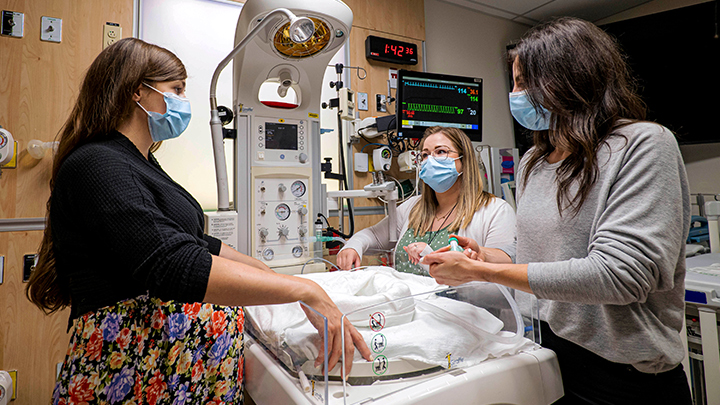
September 2, 2022

Simulation consultants Nicholle Oomen, left, Megan Rolleman and Cydnee Bryksa work in the Stollery Critical Care Simulation Lab, which opened in May 2021. Photo by Evan Isbister.
Story by Kathleen Deman | Photo by Evan Isbister
EDMONTON — It’s been a busy, rewarding year of skill-building in the Critical Care Simulation Lab at the Stollery Children’s Hospital, where simulation has been a cornerstone of the hospital’s teaching strategy since 2006.
In fact, since its launch in May 2021, the lab has attracted 965 participants to 203 simulation sessions, making it the most active simulation program in Edmonton Zone.
The program’s primary focus is offering simulation scenarios where staff can hone their skills in providing care to patients throughout their hospital journey. The lab team supports staff by reminding them it’s normal to sometimes feel out of your comfort zone and creates opportunities to practise and refresh skills and grow confidence in their abilities.
The launch of the Stollery Critical Care Simulation Lab program coincided with the opening of the new pediatric critical care redevelopment at the Stollery — a state-of-the-art space funded by the Stollery Children’s Hospital Foundation. A strong supporter of simulation for years, the foundation provided the latest equipment and the human resources to integrate simulation throughout the hospital.
“With the funding from the Stollery Children’s Hospital Foundation, we have now been able to hire two dedicated simulation consultants and a director for the hospital, and the program has expanded exponentially,” says Dr. Jonathan Duff, the medical director of the simulation lab program and associate professor in the Department of Pediatrics.
“Securing resources for a more formal program has been a challenge and, as a result, the use of simulation has been reserved to certain areas of the hospital where simulation champions have been able to integrate it into the curriculum with their learners. These new simulation consultants work with both the Stollery Hospital and the provincial eSim team.”
Some of the most impactful initiatives the program supports include the Pediatric Intensive Care Unit (PICU) Complex Patient program, Extracorporeal Life Support Activation, and Connect Care training.
In one scenario, for example, teams from the Stollery’s Extracorporeal Membrane Oxygenation (ECMO) Life Support, Operating Room (OR) and the Pediatric Cardiac Intensive Care Unit (PCICU) come together to practise an emergency process. The ‘patient’ in this simulation (a high-tech infant mannequin) starts in the PCICU — then deteriorates to experience a cardiac arrest. The PCICU team manages the arrest for five minutes before initiating the protocol to activate the ECMO life support and OR teams. These teams then arrive on the unit and surgically place the mannequin patient onto the highest level of life support.
“The opportunity for these teams to come together and evaluate processes that span across multiple departments in a controlled environment has been invaluable,” says Nicholle Oomen, simulation consultant, eSIM at Stollery Children's Hospital.
“In our first session alone, a latent patient-safety threat was found — and processes were changed in response to this finding. This type of simulation highlights how the simulation program appreciates the complexities of patient care across multiple areas of the Stollery. It shows how we can facilitate inter-department simulation to promote process improvement.”
Not only is simulation useful for practising critical skills, such as during cardiac arrests, it also has the potential to provide a safe environment for staff to consider the additional complexity of having family members present during such emergency events.
“The Stollery Patient and Family Centred Care team is excited to partner with the simulation program to develop scenarios for teams to practise the skills of delivering bad news and supporting families to understand what just happened to their child during these difficult events in a psychologically safe place,” says Joelle Fawcett-Arsenault, Patient and Family Centred Care coordinator at the Stollery Children’s Hospital.
“Staff are expected to be able to have these difficult conversations with families. But most often, they’ve never had an opportunity to practise, to get feedback, to feel confident that they are going to be the character in that families’ hospital experience that they want to be.”
As the Stollery simulation program grows, one of its goals is to provide an opportunity for every staff member to practise basic patient- and family-centred communication and receive feedback from patient and family volunteers.
In addition, the program is set to expand to offer simulation to families and caregivers of medically complex children to prepare in a hands-on way for their transition home to their community from the hospital.
Looking back over its first year, the Stollery simulation lab program enjoyed exponential growth. This coming year will focus on its expansion to areas outside of the ICU to ensure physicians, staff, students and families can experience the benefits of simulation-based education.
The Stollery simulation program falls under the umbrella of the eSIM (educate, simulate, innovate and motivate) Provincial Simulation Program — the sole body that provides governance and sets standards for simulation-based education and activities across Alberta.
“We believe this program will help drive the future of education in healthcare,” adds Dr. Duff. “High-quality education leads to high-quality care.”
This year’s international Healthcare Simulation Week runs Sept. 12-16 with the theme “Excellence in a New Era”.